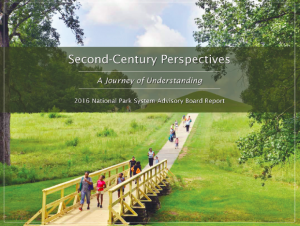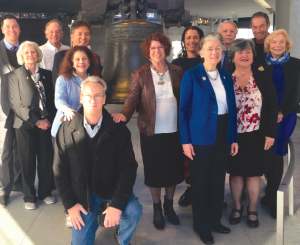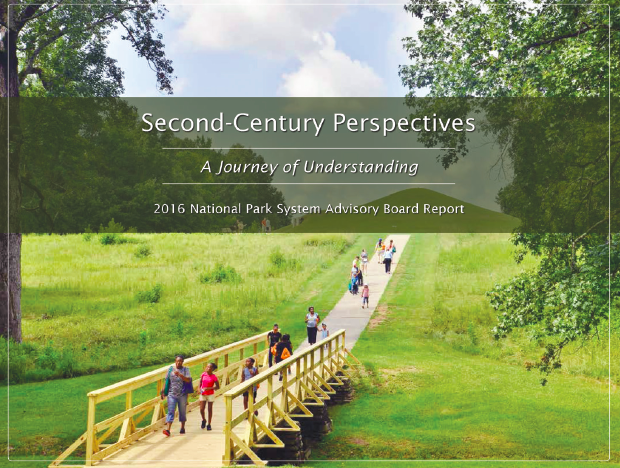by Rolf Diamant
This article originally appeared in the George Wright Forum, vol. 35 no. 1 (2018)

As 2018 began, a lesser-known but impactful component of America’s national park system, the National Park System Advisory Board, drew national media attention when 10 of its 12 members resigned to protest the refusal of the secretary of the interior to meet with them. Although the board and its activities do not often draw public attention, the mass resignation still “came as a shock,” reported the Los Angeles Times, explaining that “few groups have been closer and more involved in Interior Department policy and management than the National Park System Advisory Board, an appointed and nonpartisan group established 83 years ago to consult on department operations and practices.”
In fact, the idea of an independent advisory board to help guide US national park policy first surfaced in a 1911 letter from Frederick Law Olmsted, Jr., to J. Horace McFarland. McFarland, the leader of the fight against the proposed Hetch Hetchy Dam in Yosemite NationalPark, was drafting a bill to establish a professional national park service. Olmsted, who had inherited his famous father’s landscape architectural practice, is perhaps best known in park circles today for insisting in his letter to McFarland that the park service legislation include a “general definition of purpose” for national parks (“to conserve the scenery and the natural and historic objects and the wild life therein and to provide for the enjoyment…”).Olmsted also argued for establishing a “deliberative body … of overseers or commissioners in a position to safeguard … a harmonious continuity of policy.” Early drafts of the National Park Service (NPS) Organic Act did include provision for this advisory body. That language, however, was ultimately removed from the final version of the legislation that passed Congress in 1916. It has been suggested by historians that Department of Interior (DOI) officials (perhaps then as now) were generally uncomfortable with the idea of any independent board.
The newly established National Park Service was barely up and running before various iterations of Olmsted’s idea resurfaced. In 1918, at the request of NPS leadership, the secretary of the Smithsonian Institution, Charles Walcott, organized a National Park Educational Committee that included university presidents and representatives from leading conservation organizations. In 1928, a “board of expert advisors,” along the lines of Olmsted’s original proposal, was formally established for Yosemite National Park, with Olmsted himself appointed as the board’s first chair.
What was good for Yosemite was ultimately judged to be good for the nation. Seven years later, Congress passed the Historic Sites Act of 1935, responding to the 1933 Reorganization and expansion of NPS responsibilities for preserving cultural heritage. Section 3 of the act authorized the creation of a National Park System Advisory Board that would draw on the expertise of leading preservation thinkers and practitioners to provide advice on national parks, particularly NPS historic assets. Over the years the board’s charge was broadened to provide counsel on park operations and management as well as recommending designation of new national historic landmarks (NHLs) and national natural landmarks. Today, the board’s 12 members, who volunteer their time and expertise, are appointed by the secretary
of the interior for terms of up to four years (renewable for a second four-year term) and represent a cross-section of disciplines and knowledge relevant to the increasingly complex opportunities and challenges facing NPS. The advisory board’s current charter specifies that:
At least six of the members shall have outstanding expertise in … history, archeology, anthropology, historical or landscape architecture, biology, ecology, marine sciences, or social science. At least four of the members shall have outstanding expertise and prior experience in the management of national or state parks or protected areas, or natural or cultural resources management. The remaining members shall have outstanding expertise … in another professional or scientific discipline, such as financial management, recreation use management, land use planning, or business management important to the mission of the National Park Service.
Board chairs have included publisher Alfred Knopf, author Wallace Stegner, historian John Hope Franklin, and most recently, former Alaska governor Tony Knowles. Eminent scientists and scholars have served on the board, including A. Starker Leopold, Sylvia Earle, and Bernard DeVoto, as have conservation leaders such as Lady Bird Johnson, Edgar Wayburn, and Marian Heiskell.
Board encounters
During my own NPS career, I began paying closer attention to the work of the advisory board when John Hope Franklin became its chair near the close of the Clinton administration. It was during Franklin’s brief but important tenure (1999–2000) that the board wrote its landmark report Rethinking the National Parks for the 21st Century. The report, a touchstone for contemporary park thinking, advocated that national parks reach “broader segments of society in ways that make them more meaningful in the life of the nation” and help build “a citizenry that is committed to conserving its heritage and its home on earth.” Franklin’s
board declared that parks “should be not just recreational destinations, but springboards for personal journeys of intellectual and cultural enrichment.”
I had the good fortune as an NPS superintendent to work with a few later advisory boards, thanks in part to requests from my colleague Loran Fraser, who was formally charged with staffing the board for almost two decades (and who often informally served as its muse.) During the Bush administration, a time of relative DOI/NPS leadership inertia, I joined NPS colleagues assisting board working groups to advance a number of policy initiatives dealing with education, civic engagement, and national heritage areas. It was a particular privilege to lend an occasional hand to Dan Ritchie, the resourceful and politically adept chancellor of the University of Denver, who was then chair of the board’s education committee. Ritchie convened gatherings with some of the nation’s foremost thinkers and practitioners in the fields of education and the humanities, transforming his committee into a hub of new ideas and activity. In 2006, Ritchie’s committee organized at Independence National Historical Park a symposium with leading scholars to address the declining state of historical literacy and civic engagement. Called Scholar’s Forum: The National Park Service and Civic Reflection, the symposium highlighted the critical role of national parks as venues that provide “multiple opportunities to ‘re-enact’ experiences and stories uniquely associated with places that can reconnect people to the natural world, to their own heritage, and often to their most deeply held values and aspirations.” Participants challenged NPS to reinvigorate, in Ritchie’s own words, “active citizen participation in America’s civic life.” Later that year, Ritchie also hosted the National Park Service Interpretation and Education Evaluation Summit at the University of Denver— a pivotal event in building a “culture of evaluation” to guide and strengthen park interpretation and education. In his introductory remarks to the gathering, Ritchie explained why this work was so vital:
The survival of the national park system in the 21st century depends on how it interacts with society and how much society values it. The Interpretation and Education Program is the primary means by which the National Park Service engages diverse publics with their national parks, provides access to meanings, establishes relevance, and connects people and communities to national heritage.
In 2008, I joined with Jon Jarvis as NPS liaisons to the National Parks Second Century Commission. The commission was an independent body convened by the nonprofit National Parks Conservation Association to develop a 21st-century vision for the National Park Service. Expanding on the foundational work done by Franklin and his board, the Second Century Commission’s report affirmed that “our vision of the National Park Service and of the national parks in American life is animated by the conviction that their work is of the highest public importance … creating an enlightened society committed to a sustainable world.”
When Jarvis became NPS director in 2009, he asked me to assemble a small team of park superintendents to formulate an early action agenda for a newly reconstituted advisory board.Building on the continuity already established between the board and the commission, Jarvis and Fraser envisioned a reinvigorated, forward-looking National Park Service Advisory Board to tackle some of the national park system’s greatest opportunities and challenges as NPS approached its 2016 centennial celebration. With this in mind, eight former Second Century commissioners—Linda Bilmes, Milton Chen, Rita Colwell, Belinda Faustinos, Carolyn Finney, Tony Knowles, Gretchen Long, and Margaret Wheatley—were appointed to the advisory board, with Knowles serving as the chair. The stage was thus set for the most productive period in the advisory board’s 75-year history.
A full plate

The board hit the ground running, with the core group listed above augmented by new board members Stephen Pitti, Judy Burke, Paul Bardacke, and Lenore Blitz. From 2009 to 2016—the year of the centennial—the advisory board focused on ways to strengthen the NPS role as resource educator and steward, expand relationships with diverse communities, and foster and sustain organizational change. NPS is very much an operational organization, often devoting a limited amount of time and resources to thinking about and planning for the future. The board was repeatedly called upon to help incubate new ideas and management approaches before NPS undertook a shift in policy or a significant operational investment— understanding that change has a greater chance of success when championed by respected professionals inside and outside of government.
Much was accomplished. The board’s education committee helped NPS broaden collaboration with a wide range of formal and informal educators to promote unexplored opportunities for lifelong learning, professional development, research, and evaluation. I’ve previously written about Revisiting Leopold: Resource Stewardship in the National Parks, a report produced by the board’s science committee. Taking climate change into account, Revisiting Leopold recommended that NPS manage natural and cultural resources “in a context of continuous change that we do not fully understand.” The report strongly influenced the adoption of a new NPS policy directive, Director’s Order 100 (DO-100), for basing resource management decisions on best available science, adherence to the law, and long-term public interest.
The board facilitated discussions about the agency’s workforce culture and organizational renewal while encouraging newly formed NPS networks to share best practices and innovations. The board encouraged an independent economic valuation—for the first time taking into account factors such as carbon sequestration, watershed protection, education programming, and intellectual property—that estimated the value of the national park system to the American people at a staggering $92 billion per year. The board also prepared designation
of 59 new NHLs “that recognize the experiences of an increasingly diverse America”
and encouraged NPS to prepare a new National Park System Plan, the first in 45 years. The plan, completed in 2017, identified significant gaps in the system and opportunities for new park partnership models, large landscape conservation, and expanded urban engagement.
One of the Knowles-led advisory board’s greatest strengths was its ability to recruit outside experts—many of the best minds in their field—to work alongside NPS professionals. A multiplier effect was at work as well, as this talent pool extended far beyond the membership of the actual board itself. Board members used their extensive contacts and networks to enlist over 150 experts from schools and universities, professional organizations, conservation groups, and businesses to serve on board committees. Board working groups were staffed by a variety of NPS subject-matter specialists and practitioners with benefits flowing in both directions. NPS participation offered the board valuable perspectives and knowledge of programs from people with field experience. In return, the board ensured agency professionals had access to the best available scholarship and to new directions in their respective fields. NPS staff also engaged their board contacts in workshops, symposia, and professional development programs.
An empty plate
For almost a year following the 2016 election, the Knowles-led advisory board was, in effect, sidelined. During this period, repeated requests by the board to discuss the new administration’s agenda for national parks were turned down. In August 2017, the Department of Interior rescinded DO-100. According to E&E News, NPS spokesperson Jeremy Barnum “provided a somewhat cryptic message when asked why the Director’s Order was tossed…. Barnum stated that the order was rescinded ‘to eliminate confusion among the public and NPS employees regarding current NPS policy in light of the Department of the Interior’s new vision….’ Mr. Barnum would not, however, explain what confusion had been created or what the ‘new vision’ was.” By January 2018, High Country News reported, “with few options to make their voices heard, advisory board members decided to resign en masse.” The decision of 10 of the 12 board members, including its chair, former governor Knowles, to resign, became national news. Reuters quoted a DOI spokesperson as saying that the department “welcomed” the mass resignation.
Looking beyond this derisive remark, there will come a day, not far off, when DOI/NPS leadership, putting aside partisan grievances, will retroactively recognize and thank the members of the departing Knowles advisory board for their extraordinary efforts and wide-ranging contributions to the national park system. Until then, members of this board depart with the gratitude of NPS employees, partners, and volunteers —and all who have benefited from the board’s endeavors—and with the deep appreciation and respect of many individuals who
have worked alongside them.
The once and future board
Perhaps it is helpful to take a step back from this confrontation and consider how the advisory board’s role has changed over time. Over the past two decades the board has evolved to assist the agency in ways not necessarily envisioned when NPS or the board itself were created. Not all incarnations of the advisory board have been unqualified successes; some have been more effective than others. Recent boards have become increasingly impactful, strategically helping to advance major NPS goals. But we have also learned that a progressive evolution of board engagement and responsibility is neither inexorable nor irreversible. While the board itself is established by statute, it is only fully animated and empowered by the vigorous engagement of DOI/NPS leadership. Given current circumstances, the advisory board’s immediate prospects are unfortunately not encouraging.
I believe, however, that the broad arc of history suggests that a fully engaged and respected board will be re-established at some point in the future. The board’s charge will likely continue to grow as well, commensurate with the increasingly complex needs of our national park system. When that time comes, the advisory board will regain its voice as an effective and articulate advocate for the NPS mission and for the role of the national park system as an essential civic institution of American democracy



